Porcelain Insulator News
by Elton Gish
Reprinted from "Crown Jewels of the Wire", March 1998, page 21
In the November 1997 CJ PIN column we discussed a "new" multipart
that was assigned M-2999. It had the marking "Victor R=oo" on the top
skirt. I have been informed by the original owner that this insulator should not
have been assigned a M-number. He found the top skirt and bottom skirt about ten
years ago at the Victor dump site but at different times and locations. He later
cemented the two parts together because they fit so nicely and made this fact
known to the person he sold it to. That person's collection was sold after his
passing and several of us assumed incorrectly that this was a genuine insulator.
There is no way to confirm that these two insulator shells, though matching
perfectly in glaze characteristics, were ever intended to be joined to make this
particular insulator style. So, the previously assigned M-number has been
withdrawn. Please note this in your November 1997 issue of CJ on pages 11-12.
However, it does not take away from our earlier guess about the purpose and use
for the odd crown detail and lack of tie-wire groove.
While referencing PIN in
the November 1997 issue of CJ, note the photograph on page 12 of the submarine
insulator. We have never been able to determine the manufacturer of this unusual
insulator. A retired Locke employee sent me the photograph shown here of a
similar odd insulator that was made at Locke in Baltimore, MD. He called it the
"harp". It is 27-1/2" long, 15" high, and 1-5/8" thick.
The glaze color is mahogany and there is an incuse marking "Aug. 6,
1942" which is probably the date of manufacture. The notched bottom edge
has an unglazed surface which may have allowed it to be mounted on a metal
bracket. There are holes below each pair of grooves along the curved side which
probably held a tie-wire or other attachment device. Has anyone seen an
insulator like this?
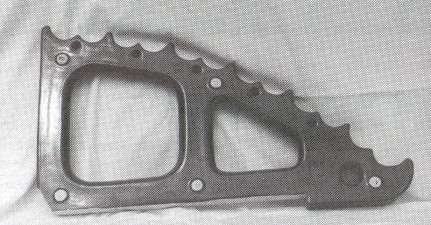
Odd "harp" insulator made by Locke in 1942.
Paul Greaves (NIA #2685) made some exciting finds looking around the
mountains in northern California and back in his home state of Colorado. Not too
long ago he found broken pieces of a Fred Locke M-2998 and glued them together
to make a rather nice specimen of this very rare insulator. Only two whole
specimens are known. The long petticoat under the top skirt was glazewelded to
the top skirt and this assembly was cemented to the bottom skirt with Portland
cement. This detail can be seen rather clearly in another photograph that Paul
took of a M-2998 top with a large part broken away. M-2998 was first cataloged
by Fred Locke in his 1902 catalog as No. 327. The illustration in that catalog
is reproduced here.
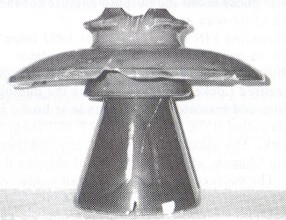
M-2998 Fred Locke (14 - 7 x 11.5)
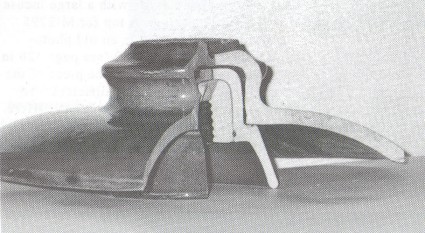
Broken M-2998 showing detail of glazeweld and cement joint.

M-2998 illustrated in 1902 Fred Locke catalog as No. 327.
Perhaps the most significant find that Paul has made is a piece of the top
skirt of M-2795. Typically these have 4-date Fred Locke markings. The earliest
M-2795's, made in the summer of 1900, have Fred Locke marking #1-5 which has
only the one 1896 patent date on one side of the top skirt and
"VICTOR" on the opposite side. We know that at least one specimen exists with a large incuse number
"303" above the "VICTOR" marking. A top for M-2795 with the
"303/VICTOR" marking is easily seen in an old photograph taken at the
Victor, NY factory in June 1900 (see page 120 in my book, Fred M. Locke: A
Biography). However, the piece of the top skirt of M-2795 that Paul found has an
entirely different marking, but, more significantly, the marking is embossed!!
[Here is where it is important to listen to all my past babble about the
importance of not referring to markings on porcelain insulators as
"embossings". Most markings are not embossed (raised) as on all glass
insulators but rather incuse (stamped into the surface).] Part of the marking is
missing on the piece that Paul found, but you can clearly see enough to
determine most of it. Note the embossed letters "OCKE" which of course
is "LOCKE" upsidedown and over the partial incuse marking
"Victor".
I am certain after seeing this marking combination that the
embossed "LOCKE" marking was the first marking used on the M-2795 which
would put it before June 1900 and part of the initial production. Embossed
markings do not work well with wet process porcelain manufacture and this
marking is evidence of that. Fred Locke quickly realized his mistake and added
the incuse marking "Victor" along with the one patent date marking.
Perhaps other pieces of top skirt will be found someday that will provide more
of the embossed marking. For now we can only assume that just the embossed
"LOCKE" was the intended marking.
Fred Locke assigned catalog number
303 to M-2795 which was the first eaves trough style. He later changed the
catalog number for M-2795 to No. 316 when the 300 series of insulators was
developed because he needed the number 303 for smaller styles. This 300 series
of porcelain high voltage insulators (for voltages from 25,000 to 100,000 volts)
was referred to as the "Victor Insulators". The 300 series included 20
styles from 300 to 319 and two other styles cataloged as 323 and 327 were
apparently added later. The 300 series was first offered in Fred Locke's 1902
catalog.

A part of the broken piece of top from M-2795.
Note the embossed marking
"OCKE"
upsidedown and over the incuse marking " Victor".
Dennis Stewart reported a new style of multipart insulator made by Franklin
Porcelain Co. The new style has been assigned M-2318 (7.5 - 5.5 - 2.5 x 5.5). It
has the incuse "FP" marking on the top skirt. The glaze color is
reddish mahogany on the top skirt and darker on the bottom skirt. An interesting
feature is a "starburst" pattern in the bottom of the cable groove. If
you refer to Jack Tod's book, Porcelain Insulator Guide Book, you will learn
that Franklin Porcelain Co. was located in Norristown, PA. The company produced
insulators only during the 1920's.
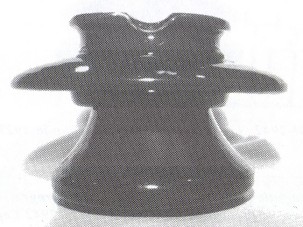
M-2318 made by Franklin Porcelain Co.
Patrick Scott got a number of the unusual M-2942 Lapp fog-type insulators.
This insulator was first reported in 5-94-14 CJ. Patrick got the remaining good
insulators off of the same bridge before it was demolished in 1997. Originally,
the bridge had 168 insulators on top of the structure. At the time of
demolition, there were only about 70 M-2942's left. All of the other insulators
had been replaced over the years with line posts. Of the 70 remaining M-2942's,
Patrick inspected about 45-50. The others were either broken or given away to
some of the workers. He got 23 good ones out of the 45-50 and two of those were
cracked. Only two of the 45-50 insulators were marked with the incuse Lapp LI
marking. All of the others had the Lapp under-glaze ink marking with the year
1927. Only one of the two incuse marked insulators was in good condition. This
makes the incuse marked M-2942's rarer than under-glaze ink marked ones.

M-2942 (12 - 7.5 x 10) made by Lapp in 1927.
The following four photographs show progressive
views of the bridge from
which the M-2942 Lapp
insulators were rescued by Patrick Scott.



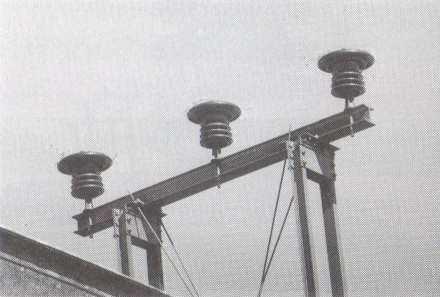
Ken Roberts (NIA #5962) reported a smaller version of Lapp's fog-type
insulator (9.5 - 6.5 x 7.5). It has been assigned M-2670. Note in the photograph
that it has three side petticoats instead of four on M-2942. John and Carol
McDougald (NIA #689 & 1076) purchased a collection last year that included
another M-2670. There may be more in other older collections.
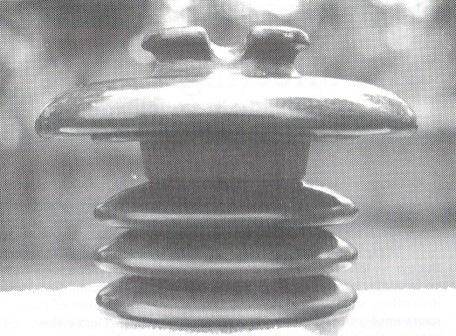
M-2670 Lapp (9.5 - 6.5 x 7.5)
| 